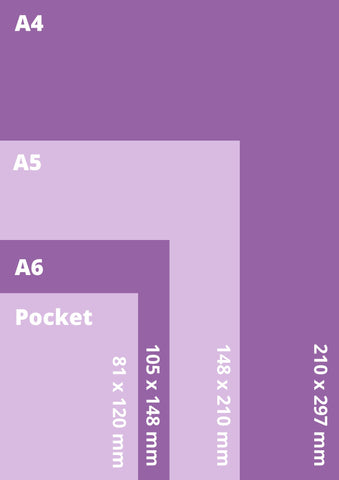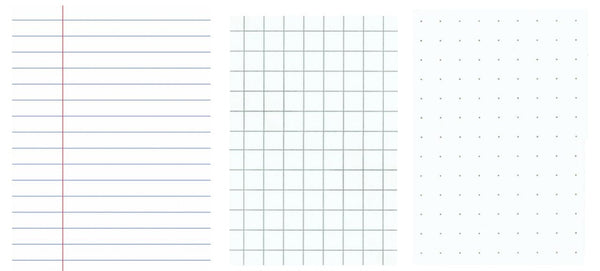
The Complete Guide to Notebooks and Journals
Richard O'ConnorShare
Notebooks and Journals are an integral part of most people's daily lives. We use them for everything, from writing notes and jotting down phone numbers to recording our deepest thoughts and musings. Students, journalists and many others simply couldn’t function without one. But how big are notebooks? What are they made from, and can they be recycled? These questions and many others are answered below in our complete guide to Notebooks and Journals.
Are Notebooks and Journals the same thing?
The first thing we need to get straight is the difference between Notebooks and Journals. Whilst technically they are the same thing, the difference between notebooks and journals is how they are used.
Notebooks are typically used for taking general notes, recording observations, and capturing ideas, whereas Journals are used for reflection or recording specific events and activities.
Notebooks typically have blank or lined pages and are smaller in size than journals, making them more portable. On the other hand, journals may be pre-formatted to help with their intended purposes, such as tracking finances, weight loss or even a baby's development. Journals also often have hard covers and thicker pages than notebooks, making them more durable.

Tip: When choosing between a notebook and a journal, consider what purpose the book will serve. For example, notebooks are better suited for quick note-taking while on the move, while journals provide more space for reflection and creative expression.
What Sizes are Notebooks?
Notebooks come in various sizes, from small pocket notebooks to large legal pads. The most common size in the UK is A5, which measures 6 x 8 inches (148mm x 210mm). This size is convenient for carrying in a backpack or purse and can easily fit into a standard three-ring binder. Half-size notebooks are half the width of a letter-size notebook, making them even more portable. Some people prefer this size for taking notes in class or on the go. Other popular sizes include A4 (the international standard paper size), legal pads (8.5 by 14 inches), and jumbo pads (11 by 17 inches). Notebooks come in a wide range of colours, patterns, and styles, so you can find one that fits your personality and needs.

What are Notebook Covers made from?
We all know to never to judge a book by its cover, it can be the only defining feature of a notebook. But what are the covers actually made from? Notebook covers are usually made from cardstock, paperboard, or occasionally leather.
Cardstock is a heavy paper often used for greeting cards and postcards. It is stiff and durable, making it a good choice for a notebook cover. It's the most common material used for notebooks as it strikes a balance between quality feel and great value, with many being made from recycled cardstock.
Paperboard is lightweight cardboard often used for food packaging. It is not as stiff as cardstock, but it is still durable enough for general-purpose notebooks, making them a cheaper alternative to premium journals.
Leather is a popular choice for high-end notebooks and journals. It is soft and flexible, providing a luxurious feel. Leather covers also tend to be more expensive than covers made from other materials. However, the trend for veganism and animal-friendly products is growing, so leather is becoming a less popular material for notebooks. Because of this, fabric and felt covers are growing in popularity for notebook and journal covers.
Read More: 16 Creative Uses for Notebooks
Notebook and Journal Page Layouts
The inside of notebooks and journals use various formats, each with its advantages and disadvantages.
- Lined paper is the most common type; it is excellent for writing neatly and keeping your handwriting even. However, it can be restrictive if you want to draw or doodle.
- Blank paper gives you more freedom to be creative, but it can be harder to stay organised.
- Gridded paper is perfect for drawing and creating tables or diagrams, but it can be challenging to write on if you're not used to the lines
- Dotted paper is somewhere between gridded and lined paper; the dots provide a subtle guide that can help you keep your handwriting neat without being too restrictive.

Unique layouts are also available for specific uses, especially with journals. For example, weight loss and financial savings journals are lined in ways to help track the progress towards your goals, whilst anxiety and wellness journals include tips and prompts to help improve your wellbeing.
What Paper is used for Notebooks?
Notebooks and journals all have one thing in common: paper. Therefore, the type of paper used in these books plays an essential role in the final product's function and aesthetic.
Notebook paper is typically lighter than construction paper, with a slightly glossy finish. This makes it ideal for writing with pens or pencils, as the ink will not bleed through the pages. However, it is also thin enough to be torn out without damaging the rest of the book.
On the other hand, journal paper is usually thicker and more textured. This helps to give the book a more refined look and makes it more durable. The thicker paper is also less likely to tear, making it a good choice for books that will be used frequently.
Ultimately, the type of paper used in a notebook or journal is a matter of personal preference. Whether you prefer the smooth feel of regular paper or the rugged look of construction paper, a note-taking book will suit your needs.
Tip: Paper thicknesses are measured in GSM (Grams per Square Inch). The higher the number, the thicker the paper. For example, 90gsm is a standard thickness for paper you'd typically find in a ream for your office printer, whereas 300gsm is used for greeting cards and notebook covers.
How are Notebooks and Journals Bound?
The most common binding method is stitching, which involves sewing the pages together with a needle and thread. This method is strong and durable, making it ideal for books that will be used frequently. Another popular method is glueing, which involves attaching the pages to the spine with adhesive. This method is less expensive than stitching but is also not as durable. Finally, some more expensive notebooks and journals have a spiral binding, which gives them even more flexibility.
For books that will be used infrequently or stored for long periods, stapling is often the preferred method of binding. This involves fastening the pages to the spine with metal staples. Stapled books are not as sturdy as stitched or glued notebooks, but they are usually sufficient for light use.
When were Notebooks first used?
Notebooks have been around for centuries, serving as a convenient way to record thoughts, ideas, and observations. The first known notebooks were used by the ancient Greeks and Romans, who used them as personal journals. The word "notebook" comes from the Latin word "noota," which means "to note down." In the Middle Ages, monks used notebooks to record religious texts. By the 16th century, commercially manufactured notebooks were available, quickly becoming popular with writers and intellectuals. Today, notebooks are essential for students, professionals, and anyone who wants to capture their ideas in a portable format.
Can Notebooks be Recycled?
Notebooks and journals serve a vital purpose in our lives, providing a place to record our thoughts, ideas, and musings. But what happens when we're finished with them? Can they be recycled?
Notebooks and journals can be recycled, but If the cover is laminated, it should be removed before being put in the recycling bin. Spiral bindings can't be processed with paper.
It's also recommended to check what's in the notebook before putting it into the recycling bin. Phone numbers, bank details and other personal information should be ripped out and shredded to protect your privacy.
So next time you're finished with a notebook or journal, don't hesitate to recycle it! With just a little effort, you can help reduce waste and keep these items out of landfills
Read More: What is the Best Time of Day to Journal?
